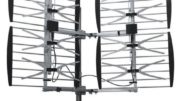It’s been a while since I wrote about subchannels. About eight months, as far as I can see. The world of subchannels has cooled a bit from years past, and we tend not to mention them as much. But, the world of subchannels is still strong, and the dozens of subchannels available in most cities make for the most compelling case for getting an over-the-air antenna. Seems to me it’s time for me to deep-dive into them again.
What is a subchannel?
Subchannels are video streams that occupy the same frequencies as regular over-the-air channels. When digital television was first being proposed, broadcasters wanted flexibility. They knew that digital technology would let them control just how their signal was put together and they wanted an opportunity to make more money. Nothing wrong with that.
You see, with digital signals, you really have a choice of how you present them. You can have a digital signal that has incredible quality and clarity, or one that is muddy and blurry. Or, you can play the odds and try to get a signal that looks “good enough” that most people don’t complain. You can decide how detailed the picture is and how much is left behind, just by compressing the picture more or less.
Traditionally, CBS stations have chosen to present the best possible picture, using the entire 19.2Mbps stream available to them for a single program source. We call this the “primary channel” and it’s what you think of when you think of over-the-air TV. It’s the network feed you’ve always enjoyed. CBS stations generally broadcast the highest possible resolution with the highest possible bitrate.
Other networks have taken a different path. Historically, ABC stations have used lower-resolution video and compressed it more. This leaves extra space for two or three other video feeds. These are called subchannels and they’re like extra free channels that you can only get with an antenna.
What are subchannels used for?
There was a lot of experimentation in the early days of subchannels. Some stations did “raw news feeds” where you could see everything happening before and after a report. Some did local educational programming, some did religious programming, and others tried to innovate with original programs that might not appeal to everyone.
Those were the early days. Eventually most broadcasters settled into a predictable pattern. Because of the limits of 2010s technology, subchannel content was almost almost always standard definition. This made it the perfect medium for older TV shows.
Today’s subchannels have names like MeTV, Laff!, Buzzr, and GetTV, and are filled with shows from the 1970s and before. It’s comfort food for the baby boom generation, still a dominant economic force but less likely to attract advertisers than they used to. Old TV shows are cheap to put on and the advertising that’s on these channels pays for the content easily.
Although, I’m certainly not putting subchannels down. I love watching old shows. I love watching them live, as they were meant to be seen, commercial breaks and all. It’s a whole form of entertainment that needs to be experienced to be understood. If you have ever sat down with a vinyl record and listened to it beginning to end you understand the calming effect of spending uninterrupted time. Subchannel TV is full of that.
Where are subchannels going?
We’ve seen in the last few years that subchannel content is starting to move to streaming. Pluto TV, the free commercial-supported live TV app, has already taken Buzzr. Comet, a subchannel network which shows old sci-fi movies, is available through its own streaming app. It’s possible that as boomers eventually move to streaming that all of today’s subchannels will follow them.
There will still be great content on subchannels, but it may be something different. I’ve talked several times about the FCC “repack” taking place now. Each TV market is giving up channels 37-51 to make room for more cell service, and in some markets that’s creating a problem. In larger markets, there just isn’t enough channel space for everyone.
The solution is “channel sharing.” New advances in technology mean that you can put two complete high-definition channels on one broadcast channel with acceptable loss of quality. In some cases, broadcasters are teaming up and sharing the cost of broadcasting. For example you’ll find an ABC and a Fox station sharing the same channel. Technically one is a subchannel of the other. However, unlike traditional subchannels, both channels are high definition and high quality.
Other broadcasters plan to use subchannel space to test out their ATSC 3.0 feed. ATSC 3.0 is the next generation of television services that will allow for 4K broadcasts, on-demand and personalized advertising. The FCC has, since 2017, allowed ATSC 3.0 broadcasts in test markets as long as the ATSC 3.0 content is the same as the regular content (known as ATSC 1.0). ATSC 3.0 is expected to stay in the test phase until about 2025. In the meantime expect broadcasters to use their subchannels for those tests.
Does that mean the party’s over?
Absolutely not. Those tests are going to go slowly. For now, boomer-friendly subchannels still have a home and they’re a great reason to get an antenna from Solid Signal.





